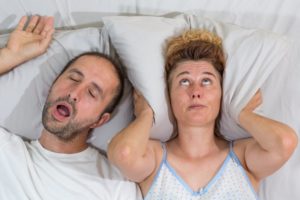 When you’re unable to get the sleep you need, you can experience a host of problems because your body’s natural rhythm has been interrupted. One of the more common contributors to lost rest is sleep apnea in Hancock Park. As you read on, you’ll learn about this condition, what causes it and two of the common treatment options available.
When you’re unable to get the sleep you need, you can experience a host of problems because your body’s natural rhythm has been interrupted. One of the more common contributors to lost rest is sleep apnea in Hancock Park. As you read on, you’ll learn about this condition, what causes it and two of the common treatment options available.
Sleep Apnea Explained
When you’re experiencing apnea while attempting to rest, it involves frequent lapses in your breathing that reawaken you repeatedly throughout the night. The result is that you spend the day feeling unrefreshed. There are two main types of sleep apnea – one that is more of a mechanical issue while the other can be considered a communication problem.
Obstructive Sleep Apnea (OSA)
The most common type of sleep apnea is OSA, which involves your lower jaw and tongue collapsing while you sleep. This can result in a partial blockage of your airway, which can cause loud snoring and lapses in breathing.
Central Sleep Apnea (CSA)
Another form of apnea is CSA, which involves the nervous system. For people who suffer from CSA, the brain fails at consistently sending the signal to the respiratory system to maintain breathing, and the lapses cause them to repeatedly awaken throughout the night.
The development of CSA can be encouraged by the following pre-existing conditions:
- Stroke
- Neurological diseases
- Congestive heart failure
What are the Symptoms Sleep Apnea?
The symptoms of both OSA and CSA are similar. Along with loud snoring, patients who suffer from either condition may wake-up with a gasping or choking sound. Additionally, they may experience throat soreness, daytime lethargy, an inability to focus and bouts of depression.
How Can Sleep Apnea be Treated?
Generally, sleep apnea is treated with a CPAP (continuous positive airway pressure) machine, which consists of a mask that is attached to a central unit that pumps air into your throat while you sleep.
A more convenient method of treatment is a removable oral appliance that is similar to an athletic mouthguard. It helps to maintain breathing by repositioning your jaw to keep your airway open while you sleep. For more acute cases of sleep apnea, a combination of the CPAP machine and an oral appliance may be used.
If you are experiencing any of the symptoms of sleep apnea, the first step is to reach out to your physician so you can be examined and to undergo a sleep study. After an official diagnosis, you can move forward with getting the treatment you need.
About the Author
Dr. Benjamin Geller is a graduate of the University of California at San Francisco, where he earned his Doctor of Dental Surgery degree. Throughout his career, he has remained an active learner, which is why he has taken continuing education courses. Additionally, he gives back by serving as a clinical faculty member at the UCLA School of Dentistry. Dr. Geller helps patients overcome sleep apnea at Geller Dentistry, and he can be reached for more information through his website.
